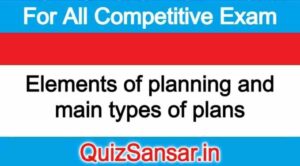
Elements of planning and main types of plans
Elements of Planning
A plan is a course of action to be taken in future. Planning is the process of deciding in advance the objectives to be achieved during a given time formulating alternative courses of action to achieve them and selecting the best course of action. For example, when a trader decides to increase his sales, he should examine various alternatives, e.g., advertising, price cut, better service to customers, etc., and choose the most appropriate course of action.
Planning is a mental exercise that requires imagination, foresight and sound judgement. It is thinking before doing. Planning is looking ahead, anticipating the future and deciding the course of action to be taken. Planning involves choice among alternative courses of action.
Following are the various types of plans:
1. Objective: Every organisation is established to achieve purpose, which is stated as objective. These are the ends results to be achieved. Therefore, in simple words, objectives are stated a what an organisation strives for’,
2. Strategy: A strategy is a comprehensive plan, which includes three dimensions:
(a) determining long-term objectives.
(b) adopting a particular course of action.
(c) allocating resources necessary to achieve objectives.
The following are the features of strategy:
(a) It is implied for a long period of time.
(b) It is formed by top level management.
(c) It may be changeable according to changes in environment.
(d) It is formed usually after SWOT analysis.
(e) It helps to cope up with environmental issues and change
3. Policy: It is a general statement that defines the boundary within which decisions are made and they direct decisions tow the accomplishment of objectives. Policy comet under the star plan, as it answers to recurring problems of a similar nature e.g. policy of, organisation regarding expulsion of employee, promotion of employee, etc.
The following features of policies are:
(a) It is a type of standing plan.
(b) It is a broad guideline specifying the way to achieve objective.
(c) It helps in decision-making and judgement.
(d) Major and minor policies are framed for outsiders and ins respectively.
(e) It provides the route to reach the goals.
4. Procedure: It describes tlie. exact manner, in which a certain activity is to be performed. It is a chronological sequence of steps be taken. These are designed to execute policies and ac objectives. These also come under the standing plan, as it prescribes ways to handle routine problems.
The following features of procedures are:
(a) They are decided on the basis of objectives and policies
(b) They are standardised in all respects, viz material, techniques, etc.
(c) They are evaluated periodically to adapt to changes.
(d) They are not based on guess work, but logical reasoning.
5. Method: It provides the prescribed ways or manner, in which a task has to be performed considering the objectives. Methods are formalised and standardised ways of accomplishing repetitive and routine jobs, thus, are considered as standing plans..
The following features of methods are:
(a) It is a type of standing plan.
(b) It is formed on the basis of operations planned and procedures.
(c) It helps in day-to-day working and smooth operations of business.
(d) It helps to save time, money and effort of resources.
(e) It is one of the steps of a procedure.
6. Rule: These are specific statements that inform what is to be done. There is no discrete allowed in rules, as they must be followed strictly and one cannot make any changes in then.
The following features of rules are:
(a) They deal with specific situation.
(b) They help to control behaviour of the employees.
(c) They are not flexible.
(d) They facilitate discipline in the organisation.
(e) They may be a part of a procedure.
7. Programme: These are the detailed statements about a project which outline the objectives, policies, procedures, budgets which are to be implemented in the project. These are concrete action. plans indicating how, when and by whom work is to be done. These also come under the single-use plans, as they are developed for particular a project.
The following features of programme are:
(a) It is type of single use plan.
(b) It is formed on the basis of objectives and policies.
(c) It includes the minutest details of work to be done.
(d) It facilitates smooth functioning in the organisation.
8. Budget: A budget is a statement of expected results expressed in numerical terms. It is a projection designed to define the anticipated costs and results in numerical terms of a single project. Thus, it comes under the category of single-use plan.
The following features of budget are:
(a) It is prepared for a specific future time period.
(b) It is objected towards a specific goal.
(c) It helps to reflect cost and cash flows involved in an activity.
(d) It is expressed in quantitative/numeric terms.






